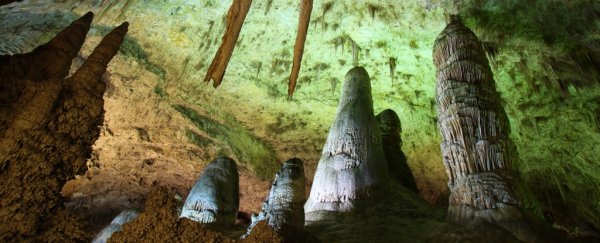
Stalagmites in Carlsbad Caverns, New Mexico. (Cabezonication/Getty Images)
PETER DOCKRILL
26 APRIL 2021
Deep underground, in mysterious caverns that seem almost measureless to humans, caves have devised their own strange ways of keeping time as the eternities pass by.
Over millennia, a ponderous exchange takes place so slowly, it makes the growing of grass look action-packed in comparison. Hanging from cave ceilings, downward-growing stalactites drip water containing chemicals onto the cave floor, which slowly aggregates into an upward-growing stalagmite.
Scientists have understood the basics of this speleothem relationship for a long time, but we're still discovering just how much of the ancient past is inscribed in these underground formations: echoes of ancient wildfires, sagas of societal collapse, and even grim predictions of our own destiny.
In a new study led by geochemist Andy Baker from UNSW in Australia, researchers have now found that stalagmites don't just record these dramatic instances of sudden and extreme climate events – they also act as natural timekeepers, chronicling the steady passage of time into the layers of rocks they become.
"Our new global analysis shows that we can consider stalagmite growth as being like a metronome and very constant over hundreds and thousands of years," Baker explains.
"In general, stalagmite growth is predictable and it is this unique property that makes them so valuable to researchers – you can tell the time in the past by using the very regular growth rings that are widely present across the globe."
In their research, Baker and his team analyzed stalagmites from 23 caves across 6 continents, looking for any common mechanisms that might explain their development.
They found that stalagmite growth rates increased in line with warmer temperatures, and that the formations only seem to grow in regions with seasonal precipitation.
While many kinds of climate disturbances can affect the ways stalagmites develop, once you average out these extreme episodes, the growth rate over time is relatively common and consistent across the globe – not to mention mind-bogglingly slow.
"The 'global average stalagmite' increased in height by about one meter over the last 11,000 years," Baker says.
Over such epic timeframes, stalagmites generally grow in an ordered fashion, much like tree rings, except for when long-lasting, multi-year disturbances – such as prolonged wet or dry years associated with things like El Niño or La Niña events – stand out in the record.
When those disturbances pass, though, the stalagmite growth layers (laminae) return to their regular rhythm, informed by the consistency of moisture descending onto them from above.
"Stalagmite accumulation rate is relatively unchanging over time," the researchers write in their paper.
"This is because their drip water source has enough volume and a stable chemical composition to be a buffer to rapid changes. Year‐to‐year, we see a 'flickering', where accumulation rate returns toward the long‐term average, also due to this buffering effect."
For these reasons, the researchers say stalagmites have much to teach us about the chronology of the ancient past – a vast archive of climate‐related proxy data we've only just begun to explore.
The findings are reported in Reviews of Geophysics.
No comments:
Post a Comment